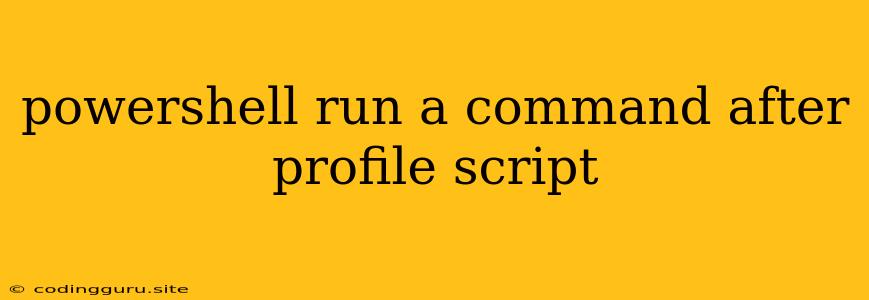Running Commands After Your PowerShell Profile Script
PowerShell profiles are incredibly useful for customizing your PowerShell environment. They allow you to set aliases, variables, functions, and even import modules to make your day-to-day work easier. But what if you need to run a command after your profile script has loaded? This is where a little bit of PowerShell knowledge comes in handy.
Why Would You Want to Run a Command After Your Profile?
Imagine you're working on a project that requires specific environment variables set or a custom module loaded. You've meticulously crafted your profile script to handle these tasks. However, you also need to execute a command to, say, start a service or check the status of a remote server. If you include this command directly in your profile, it runs as soon as you launch PowerShell. This might not be ideal if you only need that command to run under specific circumstances.
The Solutions
There are a couple of ways to tackle this:
1. Using the $PSScriptRoot Variable
This method uses the $PSScriptRoot variable, which stores the location of the script currently being run.
Steps:
- Create a separate script: Write the command you want to execute in a separate PowerShell script file (e.g.,
PostProfileCommand.ps1). - Reference the script in your profile: In your profile script, use the
Invoke-Commandcmdlet with the-FilePathparameter to execute the external script after your profile has loaded.
Example:
# Your PowerShell Profile Script
# ... other profile customizations ...
# Execute the separate script after profile load
Invoke-Command -FilePath "$PSScriptRoot\PostProfileCommand.ps1"
Advantages:
- Clean separation: Keeps your profile script focused on environment setup.
- Easy to modify: Changes to the post-profile command can be made in the separate script without touching your profile.
Disadvantages:
- Requires creating an additional script file.
- Might be less efficient than other methods for single-line commands.
2. Using Invoke-Expression with a Delayed Command
Another approach is to use the Invoke-Expression cmdlet with a string containing your command, ensuring it's executed after the profile script completes.
Example:
# Your PowerShell Profile Script
# ... other profile customizations ...
# Execute the command after profile load
Invoke-Expression "Write-Host 'This is a command executed after the profile.'"
Advantages:
- Concise: Allows you to execute single commands directly within your profile.
- Minimal setup: Doesn't require creating separate files.
Disadvantages:
- Security considerations:
Invoke-Expressioncan be a security risk if used with untrusted input, as it allows arbitrary code execution. - Less readable: Can make your profile script harder to understand.
3. Employing Event Listeners
For more complex scenarios, consider using event listeners in PowerShell. This method allows you to trigger a specific command when a particular event occurs, such as the SessionState.StateChanged event, which is fired when the PowerShell session state changes.
Example:
# Your PowerShell Profile Script
# ... other profile customizations ...
# Register an event listener for the SessionState.StateChanged event
Register-ObjectEvent -InputObject $ExecutionContext.SessionState -EventName StateChanged -Action {
# Your command to execute
Write-Host 'Profile Script Executed'
}
Advantages:
- Fine-grained control: Triggers actions based on specific events, allowing for more targeted functionality.
- Powerful: Provides flexibility for complex automation scenarios.
Disadvantages:
- More complex: Requires a deeper understanding of PowerShell events.
- Potential performance impact: Event handling can add overhead to your scripts.
Choosing the Right Approach
The best method for running a command after your PowerShell profile script depends on your specific needs and the complexity of the command.
- For simple commands: Consider the
Invoke-Expressionmethod or using a separate script. - For complex actions or event-based triggers: Event listeners provide more flexibility and control.
Conclusion
PowerShell profiles are powerful tools for customizing your environment. By strategically using techniques like separate scripts, Invoke-Expression, or event listeners, you can ensure that specific commands execute after your profile script has been loaded, making your workflow even more efficient.
